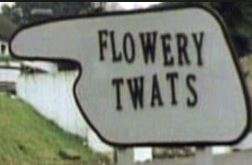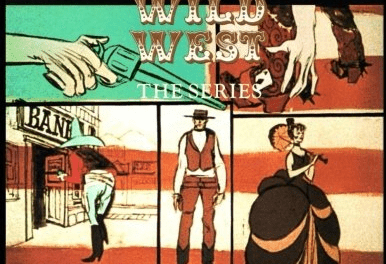The recent death of Andrew Sachs made me feel nostalgic and I re-watched Fawlty Towers. So much has already been said and written about this most celebrated of British television programs, but Sachs’ death renewed discussion of Fawlty Towers’s success. One point was the reminder that when the program was first pitched to the BBC, a memo was written heaping scorn on the quality of the writing of the pilot script. Another concern was with Cleese’s idea for the setting, and BBC staff feared that being inside a hotel would be too cramped. History proved these fears overwhelmingly wrong, but re-watching most recently, I was struck by a question about the creative decisions made by John Cleese about his program: why is it that inside Fawlty Towers looks so good?
Throughout these twelve episodes plenty of dreadful things are said about the hotel by both the guests and the staff. ‘This is supposed to be a hotel, not the Burma Railway’ is one of Basil’s comments about the effect on a (decesased) guest of spending a night under his roof. An impatient American guest declares he has found himself in ‘the crummiest, shoddiest, worst-run hotel in the whole of Western Europe’ (although one guest insists the hotel is the second worse; there is a place in Eastbourne even more terrible). In other words, the service is be lousy, the food has passed its use-by-date and the cheese gone mouldy, the views from the bedroom windows are uninspiring, and the staff on a continuum from incompetent to rude, yet the hotel itself looks terrific.
The hotel of course was a series of sets and the studio recordings were mostly done in TC8, or studio 8 at the Television Centre in White City. Sadly, the abandonment of the Television Centre spelt the death knell for this and other studios, and the birthplace of not only Fawlty Towers, but Yes, Minister, Blackadder and other comedy gems is no more. But inside the studios the BBC staff designer Peter Kindred created an elegant hotel that could almost have been a period setting.

If we imagine ourselves sitting where the studio audience was, from left to right we would have seen what would have looked remarkably like a full-scale dolls house come to life. Not all of the rooms would have been visible from the rows of audience seats and monitors were needed to see what was going on, but mostly the cast performed on big sets open to the audience view. From the left was the hotel’s bar, with vivid red wall paper, the cigarette machine, and the star-shaped clock. Travelling further to the right was a passage way that the audience couldn’t have seen where there was an antique cabinet. In front of that, which the audience could see, was the hotel’s private office with an antique roll top desk, a safe, and filing cabinets. Carrying on next is the piece de résistance, the big lobby set. The hotel staff can take cover from irate guests behind a counter and there are pigeon holes for the letters. The lobby has a grandfather clock and other pieces of antique furniture dotted around. A staircase decorated with elegant plaster scrolls leads up to the bedrooms and a door leads to the dining room. Inside the dining room, we find more antique furniture, vases with flowers and full table service at tables set with tablecloths and cruets.
That’s the inside. The exterior filming for Fawlty Towers used a country club in Buckinghamshire, lamentably destroyed by fire in the early 1990s. The building was a pleasant-looking Georgian structure that makes an interesting design statement. Remember the establishment is called Fawlty Towers, and while the structure is quite impressive it definitely does not have anything as baronial or stately as a set of towers, but the name is of piece with Basil’s pretentiousness. After all, this is an hotelier who sends invites with the stipulation ‘no riff raff’.

Peter Kindred was a highly experienced and versatile designer. Before working on season one of Fawlty Towers he had created a futuristic rocket base for Doctor Who and after Fawlty Towers he moved onto prestigious period dramas like The Mayor of Casterbridge with Alan Bates. Kindred had the skill and imagination to do anything from Victorian England for Wuthering Heights to the swinging sixties for Adam Adamant Lives! He was designer for the first six episodes of Fawlty Towers, creating the elegant, spacious interiors of the crummiest hotel in England.
It’s well known that Cleese planned the smallest detail of his show. He thought long and hard about questions like should both Basil and Manuel have moustaches, or would two moustaches in one show be too much? There is accordingly nothing random in Kindred’s designs that conjured up in a studio such a well-appointed and really quite elegant hotel.
The setting and the sets participate directly in the comedy. Jerry builders wreak havoc in one episode, taking away doors that should be there and installing doors where they shouldn’t be. Upstairs is what the Telegraph’s Sinclair McKay calls the ‘strange, superfluous little staircase on the hotel’s first floor’, but it was another deliberate decision. As Sinclair notes, ‘it was put there deliberately by the director, who recalled such an absurd device in a real Edinburgh hotel. It also helped to exacerbate the sense of frantic movement’. Another writer, Erik Adams, praises these sets as ‘a marvel of television set design, and I’m endlessly impressed with the way each room flows into the next while still providing enough cover for door-slamming misunderstandings’.
That’s praise for the way the set design enables the high farce, but my question of why make such a dysfunctional hotel look so good takes us back to the creative crucible for the show when Cleese and Monty Python colleagues stayed at the Gleneagles hotel in Torquay. Their stay is now comedy legend, because of the allegedly phenomenal rudeness of the Gleneagles’ manager. But included on the BBC’s DVD release were some interviews with people who knew the Gleneagles, and therein I think are some further insights to not just the rudeness but the good taste found at Fawlty Towers. One of the reminiscences was that while the manager was rude to his guests, his hotel was actually beautifully appointed, and other Torquay hoteliers were jealous of how nice his establishment was.
Cleese deeply imbibed the experience of staying at the Gleneagles, but the experience I feel must manifest in more than just the scripts and the characters but also the unexpectedly well-appointed and tasteful interior to Basil Fawlty’s hotel. We could expect that the hotel looks like what it is, the worst run hotel in Europe, but it looks anything but. What better to offset the dreadful service, the hotel manager’s rudeness, and the incompetence of the staff than unexpectedly pleasant surroundings; or is it the other way around and the rudeness and incompetence are unexpected in such a well-appointed establishment? My nostalgic reviewing of the series was the latest of the countless times I have seen Fawlty Towers but it did prompt a new appreciation of Kindred’s design flair, Cleese’s ability to adapt from his own time in a dreadful hotel in Torquay, and the importance of these studio sets to creating the second worst hotel in Western Europe.



Dr Marcus Harmes lectures at the University of Southern Queensland, Toowoomba, Australia. He has authored books including Doctor Who and the Art of Adaptation (2014) and the entry in the Devil’s Advocates series on The Curse of Frankenstein.






I really enjoyed this angle on Fawlty Towers. I agree with you about the set design, but had never thought of it in this way before. Such a classic series – it’s been a while since I last saw it, but now I want to watch it again. Thanks!
You mentioned TVC. Three of the studios are still in use and have been completely refurbished. i can’t remember which studio numbers they are. The building is now multi-purpose. The BBC has a share in it. Regarding the set i always remember that the grandfather clock is different in the two series. I presume they wold have liked to use the same one for the second series but found it wasn’t available.
What ever happen to the Bear Hat and Umbrella stand at the front corridor to the hotel?
I have one just the same . Mine came from Canada in the 1960s. Just curious if it is still around